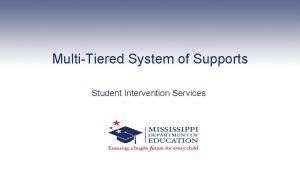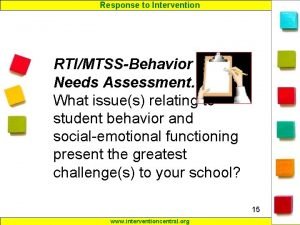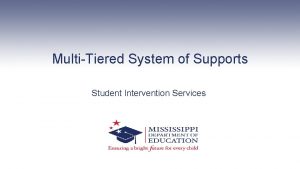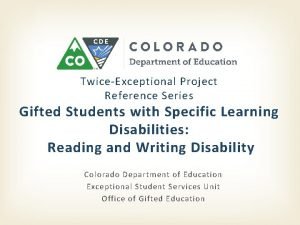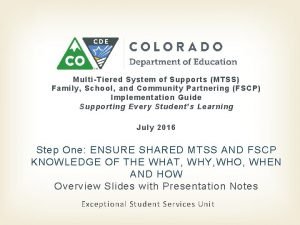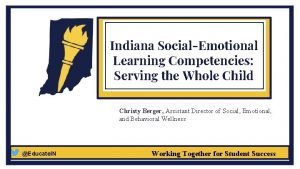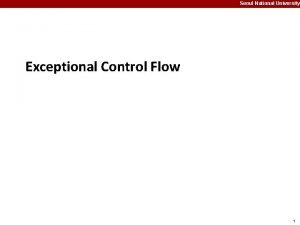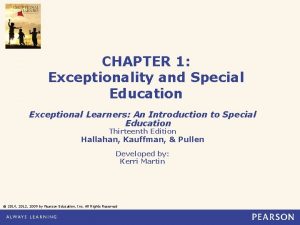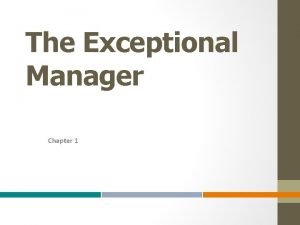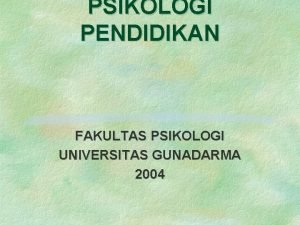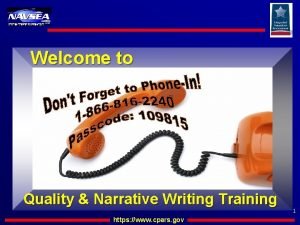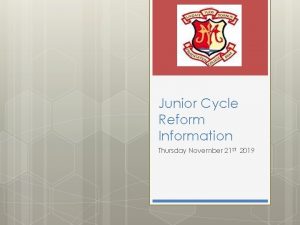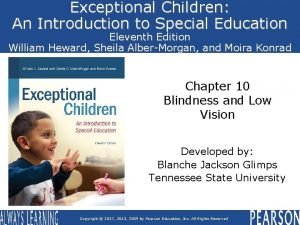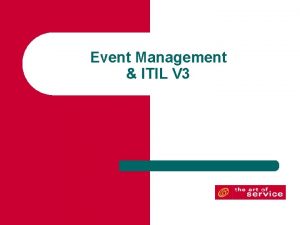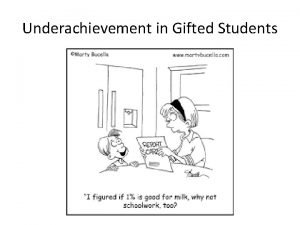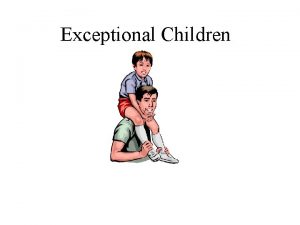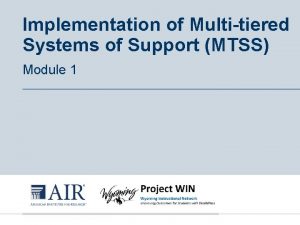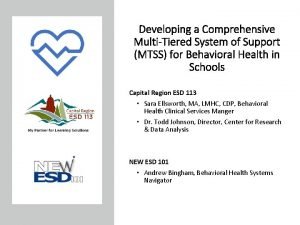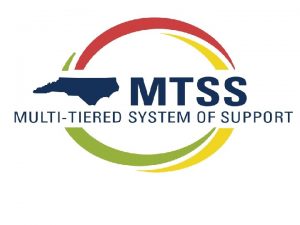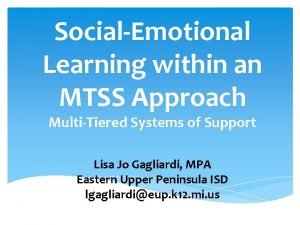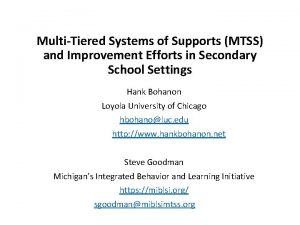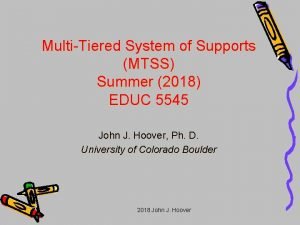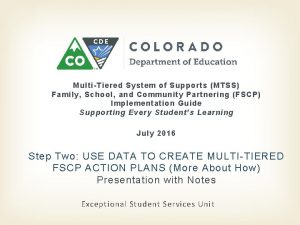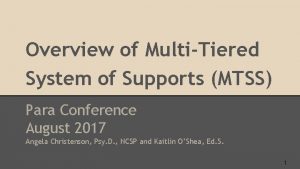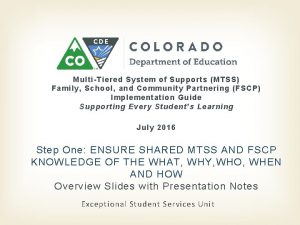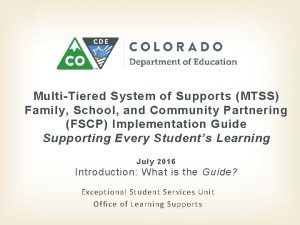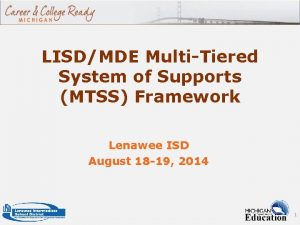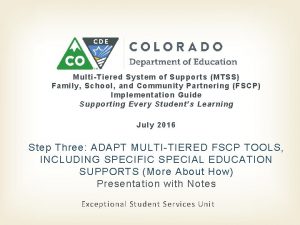MultiTiered Systems of Support MTSS Department of Exceptional































- Slides: 31

Multi-Tiered Systems of Support MTSS Department of Exceptional Student Education 1

https: //padlet. com/jonesg 6 12/14/2021 2

3

Roadblocks or Clear Paths Essential Question: What creates a roadblock for the School Support Team (SST) process? 4

Objectives 1. Understand the role of Administrator in the process. the 2. Understand the four functions. 3. Identify the essential elements Response to Intervention (Rt. I). 4. How to navigate through the Rt. I process. of 5

As an Assistant Principal… Pg. 5 of SST manual: As the SST facilitator, you must ensure monitoring and management of the process as well as identifying core and supplemental members as needed based on function of the meeting. School Psychologists are not actively involved in the Rt. I process at the school level. Psychologists are responsible for the social screenings at the time of the SST meeting and to ensure that the referral packet is complete. 6

As the Principal……. . Develop the infrastructure: Are systems in place? Data systems are active (collection & analysis) Roles & responsibilities Infrastructure of Tier 3 Start the funneling process: WHO NEEDS MORE? 7

Functions of SST Child Find for Exceptional Student Education Response to Intervention Consultation Crisis intervention Post-crisis support Retention 4. Section 504 Evaluation and Support Planning 1. 2. 3. 8

Function 1 SST For Child Find SST is the team that : processes information. plans and conducts comprehensive evaluations for students suspected of having disabilities. Obvious handicapping conditions require an immediate referral for an evaluation. 9

Function 1 SST for Child Find Parent request for a comprehensive evaluation of a public or private school student. Consent for evaluation must be obtained within 30 calendar days of parental request. School provides evaluation within sixty (60) calendar days timeline. School psychologists have ten days to write their reports. SST fulfills both the Tier III problem solving function and Child Find function simultaneously. 10

Function 2 Response to Intervention Function 2 of the SST process is solely about Rt. I is a multi-tiered approach of providing high quality instruction and matching intervention to the student’s need. Duration of Rt. I (Tiers I-III) approximately 10 -12 weeks. The key components of Rt. I are: Delivering evidence based instruction/intervention. Developing an infrastructure for a school-wide intervention system. Implementing an integrated data collection/assessment system to filter struggling students and to make data driven decisions at each Tier. Active involvement from the school-based leadership team. 11

Function 3 Consultation Student Crisis Immediately following a crisis episode, a trained mental health professional must determine risk. After the immediate crisis the SST team must convene to determine appropriate support services. 12

Function 3 Consultation Post Crisis Student Support For those students who have been hospitalized for stabilization (voluntary or involuntary), SST consultation is required upon their return to school. SST will identify appropriate interventions for the student and determine if a referral for evaluation is appropriate. Additional data may be collected after the consultation for those students referred for an immediate evaluation. 13

Function 3 Consultation Grade Retention Student Progression Plan requires SST Retention meeting for students being considered for possible retention. If the student is retained, the school site should continue with the Rt. I process. Team members include administrator, teacher. parent, and Team reviews targeted student’s progress data to determine if retention is needed. 14

Function 4 Section 504 SST coordinator receives all 504 requests. SST considers the information for possible referral for 504 eligibility meeting. School considers 504 meetings for accommodations. 15

Working the Rt. I process Data, Data 16

Effective interventions are a part of a continuum of support provided to intensity the instruction and improve student performance in the core. Core Instruction for ALL students TIER 1 Targeted Intervention for SOME students TIER 2 Intensive Intervention for FEW students (driven by individual student need) TIER 3

The Purpose of RTI Rt. I provides a framework that integrates assessments, instruction, intervention and progress monitoring. The goal is to: Ensure that ALL students receive effective core instruction in the general education classroom. Identify students who are not making adequate academic or behavioral progress early, and provide them with immediate and effective intervention. Validly identify students with a disability and provide them with high-quality exceptional student education services. 18

Navigating through the Tiers Tier 1 District assessments identify students as “high risk” Tier 2 Lack of positive response Tier 3 If eligibility req. are met then SPED is considered 19

ØThe general education teacher provides effective core instruction. ØThe teacher uses universal screening and progress monitoring data to identify students who are not meeting grade-level expectations. ØThe teacher provides differentiated instruction to students who are experiencing difficulties using explicit and targeted research-based instruction and intervention.

ØTargeted, research-based intervention for small groups of students with similar readiness needs. ØImplemented outside (in-addition) of the 90 minute reading block and instruction delivered by an interventionist or classroom teacher. ØShould occur 5 times a week, in sessions that last 30 minutes. ØTeachers use progress monitoring (e. g. i-Ready Growth Monitoring) data to guide instruction and monitor students’ response to intervention.

Tier 3 is what FEW students receive and is the most intense service a school can provide to a student. Tier 3 focuses on: • Instruction and supports are individualized based upon student needs. • When students receive Tier 3 interventions, they still continue to participate in Tiers 1 and 2 instructions. • A four-step process can help define and strategically plan the support to close the instructional gap. • Step 1 -Problem Identification: Defining the Problem • Step 2 -Problem Analysis • Step 3 -Intervention Development and Implementation • Step 4 -Evaluate Progress: SST/PST Follow-Up Meeting 22

The goal of Intervention and supports is to improve student performance under Core expectations.

Footer Text 12/14/2021 24

25

Preview Meeting: Collecting the Evidence THE WHAT: Two forms prior to SST: RFA (FM 7073) & Data Profile Sheet (FM 7452). i-Ready Growth Monitoring report (or Tier 2 On Going Progress Monitoring data). i-Ready individual performance domains (instructional match). Set a date for the SST meeting & generate notification of meeting. THE WHO: Identify team members and designate responsibilities. 26

Tier 3 Infrastructure Planning for who, what, when & where When during the school day is targeted instruction delivered? 27

Initial Meeting Review all pertinent data. Pinpoint the student’s instructional level & develop intervention plan. Two forms during SST meeting. Gap analysis (FM 7450) & Tier III Intervention plan (FM 6290). 28

SST Follow up Meeting Review Progress Two forms after SST Follow-up (FM 7453) & Fidelity Checklist (FM 7451). Determine next steps based on students’ type of response. 29

Resources MDCPS Rt. I website: http: //rti. dadeschools. net FCRR – www. fcrr. org National Center on Rt. I – www. rti 4 success. org Florida Rt. I – www. florida-rti. org/ National Reading Panel – www. nationalreadingpanel. org 30

Contact Information Ms. Elena Camacho, Instructional Support Specialist ecamacho@dadeschools. net Mrs. Karen Embden, Chairperson, Placement Specialist kembden@dadeschools. net Dr. Jorge E. Garcia, Chairperson, Psychological Services JGarcia 1@dadeschools. net 12/14/2021 31
 Decision support systems and intelligent systems
Decision support systems and intelligent systems Mtss and udl
Mtss and udl Mtss meme
Mtss meme Mtss-b
Mtss-b Symphonylearning com
Symphonylearning com Mtss needs assessment
Mtss needs assessment Mtss documentation packet
Mtss documentation packet Benefits of mtss
Benefits of mtss Mtss
Mtss Mtss nebraska
Mtss nebraska Decreto 283/996
Decreto 283/996 Mtss infographic
Mtss infographic Idoe science of happiness
Idoe science of happiness Exceptional control flow
Exceptional control flow Raleigh and rosse case analysis
Raleigh and rosse case analysis Exceptional children 10th edition
Exceptional children 10th edition Exceptional learners: an introduction to special education
Exceptional learners: an introduction to special education Exceptional manager
Exceptional manager Kategori exceptional people
Kategori exceptional people Cpars contractor response examples
Cpars contractor response examples Maths cba 1 ideas exceptional
Maths cba 1 ideas exceptional Introduction of exceptional child
Introduction of exceptional child Exceptional event in itil
Exceptional event in itil Fonzie actor
Fonzie actor Exceptional hands
Exceptional hands Exceptional children 10th edition
Exceptional children 10th edition Twice exceptional kids
Twice exceptional kids Factors influencing altruism
Factors influencing altruism Conclusion of exceptional child
Conclusion of exceptional child Exceptional children an introduction to special education
Exceptional children an introduction to special education Support department cost allocation
Support department cost allocation Minor details examples
Minor details examples




